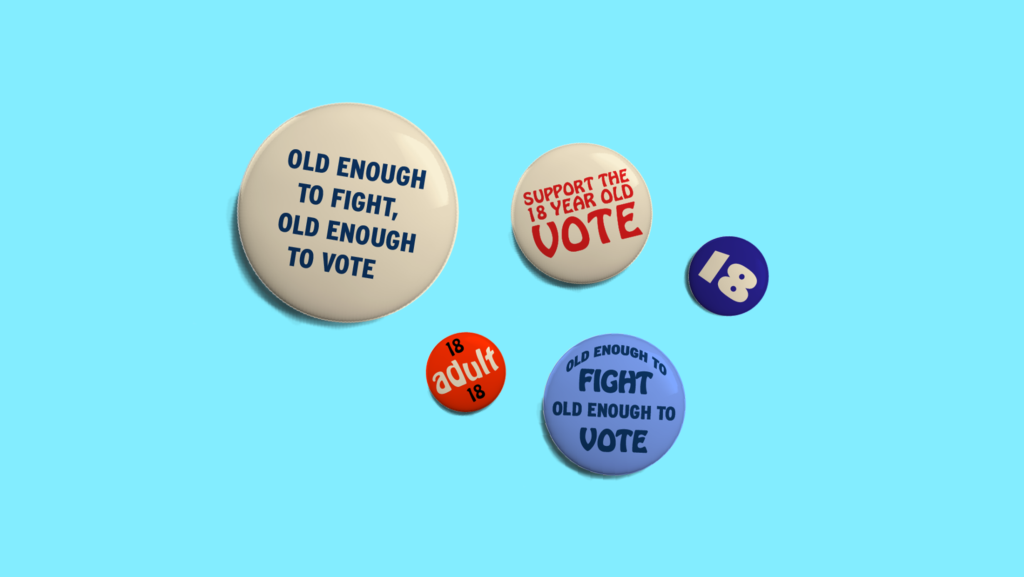Here’s How the 26th Amendment Protects Voting Rights

The 26th Amendment was ratified July 1, 1971, lowering the voting age to 18 and prohibiting any voting laws that disproportionately burden a particular age of voters. Additionally, the 26th Amendment also grants Congress the power to “enforce this article by appropriate legislation.” In the 50 years since its passage, the Amendment has protected voting rights for Americans of all ages, most significantly young voters.
“Old enough to fight, old enough to vote”
The fight to change the voting age from 21 to 18 began 30 years prior to the Amendment’s passage. In 1942, President Franklin D. Roosevelt decreased the age for military service to 18 to meet the demand for troops in World War II, while 21 remained the legal voting age in every state. Federal legislation to lower the voting age was introduced in Congress that same year but did not gain any traction. Georgia amended its state constitution in 1943 to make the voting age 18, but similar attempts in other states at the time were not successful.
It wasn’t until the 1960s that the youth suffrage movement found solid footing as a pressing political issue. In 1963, President John F. Kennedy formed a commission to investigate the country’s low voter participation rates. The Commission on Registration and Voting Participation’s report suggested, among other ideas, that states consider allowing “voting by persons 18 years of age.” This growing political support was matched by fierce opposition to the Vietnam War and the ongoing draft.“Old enough to fight, old enough to vote,” first used during World War II, reemerged as a rallying cry to highlight the hypocrisy that men aged 18 to 20 were eligible for mandatory military service yet were not eligible to participate in the political processes of their country.
Buoyed by anti-war activism, the youth suffrage movement was also driven by an intersectional, politically diverse coalition of supporters. By the late 1960s, politicians and organizations from both sides of the aisle supported lowering the voting age and groups from the National Education Association to the United Auto Workers lobbied for federal action. In particular, leaders from the civil rights movement harnessed their experience advocating for racial equality and were instrumental in bringing the issue in front of Congress and pushing the youth suffrage movement to the finish line.
In response to growing public demand and the activism of youth suffragists, legislators tacked on a provision to the Voting Rights Act when it was reauthorized in 1970 that lowered the voting age to 18 for federal, state and local elections. The statute’s constitutionality was immediately challenged by multiple states, and in late 1970 the U.S. Supreme Court ruled in Oregon v. Mitchell that Congress could lower the voting age to 18 for federal elections, but not for state elections.
Realizing the nightmare this would cause for election administration — keeping two separate voter rolls, one for federal and one for state elections — Congress acted quickly to lower the voting age through a constitutional amendment. On March 23, 1971, the 26th Amendment was passed by Congress. It was ratified by two-thirds of the states on July 1, 1971 — less than four months after it was introduced, the fastest time period a constitutional amendment has been passed. The voting age was now officially 18, and no level of government was allowed to deny or abridge the right to vote for anyone older than that on account of age.
The 26th Amendment’s legacy and its impact today
The 26th Amendment was critical for enfranchising young adults and ensuring that no laws restricting the ability to vote on account of age are allowed to stand. While young voters have historically lower turnout than older voters, youth participation has increased in recent elections, with about half of all eligible voters aged 18-29 voting in the 2020 general election (compared to only 39% turnout in the 2016 general election).
However, Republican-led states across the country have recently introduced and enacted a slew of voter suppression laws, some of which disproportionately impact young voters. Some laws which may appear neutral, such as strict residency and voter ID requirements, are more likely to impact young voters who move frequently for school or work. Other actions, such as attempts to limit early voting opportunities for college students or to restrict voter registration and education on college campuses, are openly attempting to limit the voices of young voters. Laws such as these have been and will continue to be challenged in court on the basis that they violate the 26th Amendment by denying or abridging the right to vote on account of age.
Along with laws blocking or inhibiting their ability to cast a ballot, young voters also face many structural barriers that can deter them from participating in the voting process at all. Some examples of common obstacles include:
- Confusion around local election procedures, including how to register, where and when to vote or how to request an absentee ballot.
- Time, transportation and logistical challenges around casting a vote in person, particularly for lower-income youth.
- General lack of reliable and accessible election information.
The 26th Amendment protects the right to vote for any eligible individual over 18. While there is still work to be done to address legal and structural barriers to voting for individuals of all ages, races and socioeconomic statuses, the 26th Amendment remains an important tool in fighting voter suppression.